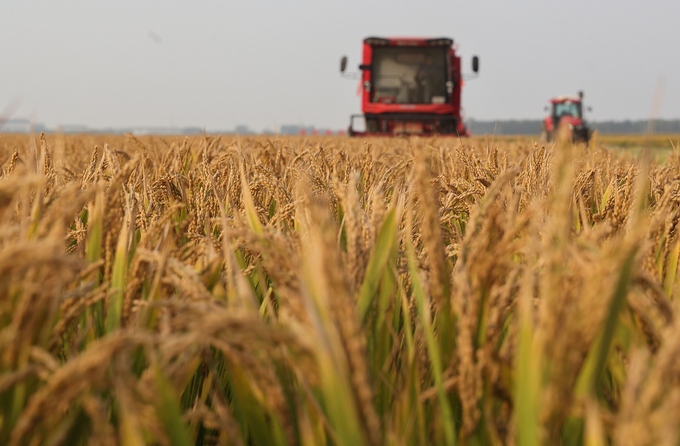May 23, 2025 | 06:12 GMT +7
May 23, 2025 | 06:12 GMT +7
Hotline: 0913.378.918
May 23, 2025 | 06:12 GMT +7
Hotline: 0913.378.918

Harvesting rice at Shalan farm in Linyi, east China's Shandong Province, October 26, 2024.
China's grain output is projected to reach a record high of 700 million tonnes this year, the Ministry of Agriculture and Rural Affairs said on Friday.
This anticipated milestone follows nine consecutive years of maintaining grain output above 650 million tonnes, the ministry stated at a press conference.
As of Thursday, northeast China's Heilongjiang Province, the country's top grain producer, had harvested more than 90 percent of its crops, or 220.9 million mu (about 14.7 million hectares) of planting area, according to the provincial department of agriculture and rural affairs.
Harvesting is expected to be fully completed in the province before the end of this month.
Heilongjiang experienced a cold spell and lingering rainy weather from June to July this year, which hindered the growth of crops in many parts of the province.
From January to August, the province had 171 million mu (11.4 million hectares) of grain growing area covered by crop insurance, up 4.27 percent year on year, with the insurance coverage rate in the province standing at 77.7 percent, according to data from the Heilongjiang branch of the National Financial Regulatory Administration.
Chinese farmers have resisted various disasters to achieve the grain harvest, as the country has grappled with extreme weather events occurring with increasing frequency this year, featuring both relentless heat and heavy downpours.
Farmers attribute the hard-won bumper harvest to the combined effects of the authorities' swift actions in disaster relief, the continuous building of high-standard farmland, the promotion of modern and even smart farming, and the timely payment of agricultural insurance.
Shi Zejie, a farmer in Zhecheng County, central China's Henan Province, said that although his field is high-quality farmland, a severe drought in June deprived it of irrigation water. He hurried to hire more than 100 people to pump water into the field round-the-clock to rescue the seedlings on over 10,000 mu (over 666 hectares) of corn and sorghum.
In the middle of July, the same field was subjected to continuous heavy downpours, and Shi had to hire people for drainage work. Under the coordination of the local authority, more than 40 pumping engines were sent promptly to help save his plants.
According to the county's meteorological service monitoring, the average precipitation in Zhecheng reached 397 millimeters from July 15 to 18, while the county's annual precipitation in the past 30 years averaged 767 millimeters. Half of the annual precipitation occurred during just three days of extreme rainfall in July.
Shi has now harvested his corn, and the field's per-unit yield is 25 percent less than that of a normal year. However, he is satisfied with the hard-won results of the planting battle this year. Furthermore, the local authorities have helped farmers rebuild irrigation and drainage infrastructure following the disasters.
Shi recently received 100,000 yuan (over $14,000) in insurance indemnity for his disaster-damaged corn field.
Data from the Henan investigation group of the National Bureau of Statistics shows that Henan reaped a total summer grain output of 37.9 million tonnes, 6.64 percent higher than that of last year, safeguarding the province's role as the country's second-largest grain producer. Although its autumn grain fields suffered losses, harvesting will soon be completed on 76 million mu (about 5.1 million hectares) of crops. Henan's annual grain output is expected to remain stable at more than 65 billion kilograms.
Meanwhile, in central China's Hunan Province, Zhang Shunda, a veteran grain grower in Taoyuan County, in the city of Changde, has been busy harvesting rice in his 600-mu (40-hectare) field these days. Foreseeing the harvest of more than 300,000 kilograms of rice, the farmer let out a sigh of relief.
The heavy rainfall caused severe damage to early rice growth in Taoyuan, the top grain grower in Hunan. The local authority promptly took measures to help farmers weather the disaster.
Zhang recalled that technicians dispatched by the county and township governments visited him to investigate the damage after the snow disaster and guided him on rebuilding and heating the warehouse to melt the snow. He has received 80,000 yuan (over $11,000) of disaster relief subsidies and more than 300,000 yuan (over $42,000) of policy subsidies for rice planting.
According to the Hunan provincial department of agriculture and rural affairs, grain production in the province remained sound this year. The harvesting of more than 22 million mu (1.47 million hectares) of middle-season rice in the province has been completed, with an estimated yield growth of about 1 percent year on year. Harvesting is nearing completion in more than 19 million mu (1.27 million hectares) of late rice fields, which can expect a yield increase of 1.5 percent year on year.
(Xinhua)

(VAN) Alt Carbon has raised $12 million in a seed round as it plans to scale its carbon dioxide removal work in the South Asian nation.

(VAN) Attempts to bring down the price of the Japanese staple have had little effect amid a cost-of-living crisis.

(VAN) Fourth most important food crop in peril as Latin America and Caribbean suffer from slow-onset climate disaster.

(VAN) Shifting market dynamics and the noise around new legislation has propelled Trouw Nutrition’s research around early life nutrition in poultry. Today, it continues to be a key area of research.

(VAN) India is concerned about its food security and the livelihoods of its farmers if more US food imports are allowed.

(VAN) FAO's Director-General emphasises the need to work together to transform agrifood systems.

(VAN) Europe is facing its worst outbreak of foot-and-mouth since the start of the century.